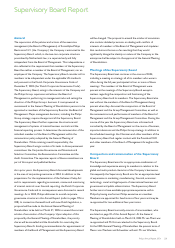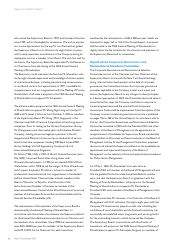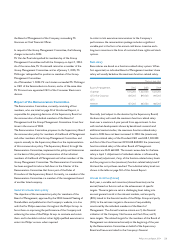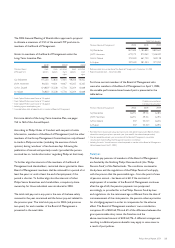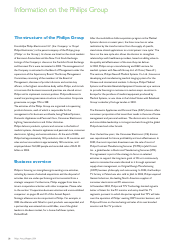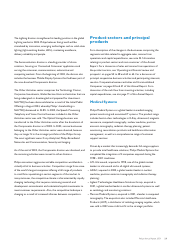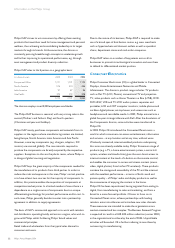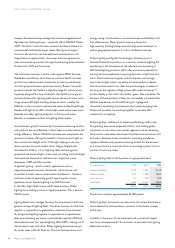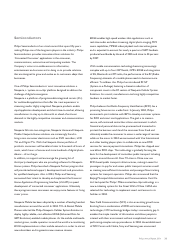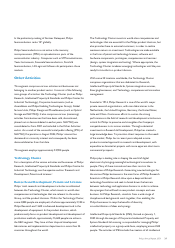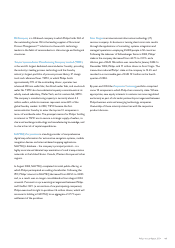Philips 2004 Annual Report Download - page 32
Download and view the complete annual report
Please find page 32 of the 2004 Philips annual report below. You can navigate through the pages in the report by either clicking on the pages listed below, or by using the keyword search tool below to find specific information within the annual report.
Philips Medical Systems sales to third parties on a geographic basis:
(in millions of euros) 2002 2003 2004
Europe and Africa 1,796 1,772 1,840
North America 4,159 3,235 3,025
Latin America 170 141 164
Asia Pacific 719 842 855
6,844 5,990 5,884
The sales performance presented in the table above is on a
nominal basis. However, currency effects (mainly the US dollar)
and changes in consolidation (mainly the divestment of HCP in
2002) had a significant influence on Philips Medical Systems’ sales
growth. On a comparable basis, sales growth was 7% in 2003 and
4% in 2004.
Philips Medical Systems employs approximately 30,800 people.
The market has a partial seasonality as a relatively large part of the
revenue is recognized in the fourth quarter.
Philips Medical Systems’ products and services are primarily sold
to healthcare providers throughout the world, consisting of
academic institutions, large and small independent hospitals, clinics
and physician practicers, and increasingly large enterprise institutes
(hospital chains and group purchasing organizations). A very small
percentage of revenues is directly generated with consumers – e.g.
through home monitoring equipment and related services as well
as a home defibrillator introduced in 2003. Most imaging systems
and clinical information solutions are sold directly to the end-user,
where installation of the system and personnel training are an
integral part of the deal. The marketing and sales channels used are
mainly direct sales and service as well as specialized system
integrators and distributors in certain geographical areas.
In most countries in the world, the Company’s processes,
products and services need to be consistent with specific demands
of ministries of health and regulatory authorities (e.g. FDA in USA,
TüV in Germany). Philips Medical Systems seeks to be fully
compliant with regulatory requirements in all markets it serves.
Growth and profitability are driven by continuous clinical
innovations and breakthroughs in combination with collaborative
customer relationships. The success of clinical innovation,
however, is dependent on governments that strongly influence the
volume of procedures with their reimbursement schemes. In
addition, through efficiency measures and increased use of remote
diagnostics of our installed systems, continued opportunities exist
to improve the operating result in the customer services area.
Domestic Appliances and Personal Care
In 1939 Philips introduced its first shaver, the Philishave. The
management of Philips decided in 1950 to start a new division
around Philishave and called it Small Household Appliances, based
in Eindhoven. Through own developments and acquisitions, the
business expanded rapidly. In 1972 the activities were split into
Domestic Appliances and Personal Care (DAP) and Major
Appliances. In 1988, the latter activity was sold. In the nineties
several expansions into new markets were realized globally, in the
USA, in China and in Europe.
Philips DAP is engaged in developing, manufacturing and marketing
innovative appliances in the field of shaving and beauty, oral
healthcare, food and beverage appliances, and home environment
care (garment and floor care). Philips DAP holds leading positions
(in electric shavers for men globally, in coffee makers, including the
Senseo, in Europe, and in rechargeable electric toothbrushes in the
USA) under the Philips brand and other brand names.
Philips has a leading position in electrical dry and wet male shaving
and grooming products. In its beauty portfolio, Philips has a range
of products which are used for female depilation, haircare and
tanning solaria. At the end of 2002, Philips sold Payer
Elektroprodukte to Hui Holding Sdn. Bhd. of Malaysia.
In oral healthcare, Philips holds a leading position in the USA in
terms of market value. The Sonicare toothbrushes are also
marketed to key countries such as Japan, South Korea, Germany,
the United Kingdom and the Netherlands.
Furthermore, Philips DAP provides food and beverage appliances,
such as mixers, blenders, food processors and toasters. In 2001,
the Senseo coffee maker, the breakthrough concept for the
traditional coffee segment that was developed in partnership with
Sara Lee/DE, was introduced onto the market. This product has
been successfully marketed in the Netherlands, France, Germany
and Belgium. During 2004 it was also launched in the United
Kingdom and the USA. In 2004, Philips and InBev launched
PerfectDraft, a new system that combines a high-quality appliance
and consumer-preferred beer brands in light metal kegs to give the
great taste of draft beer in the comfort of the home.
In home environment care, Philips manufactures and markets
vacuum cleaners and irons. In 2004, Philips and Unilever launched
the Perfective, a state-of-the-art steam iron with the Dutch
Robijn-brand anti-crease liquid in a cartridge in the Netherlands.
31Philips Annual Report 2004


